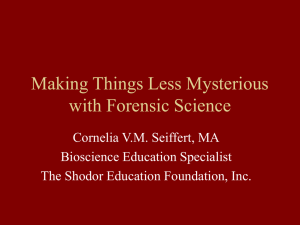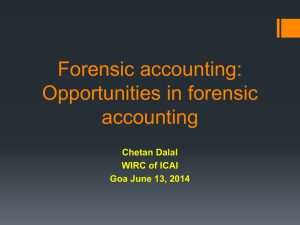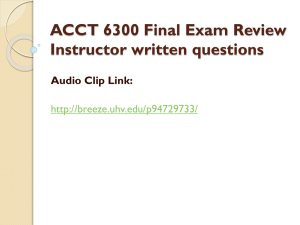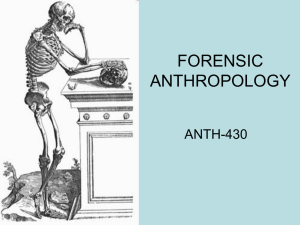Forensic Tools and Techniques for Internal Auditors
advertisement
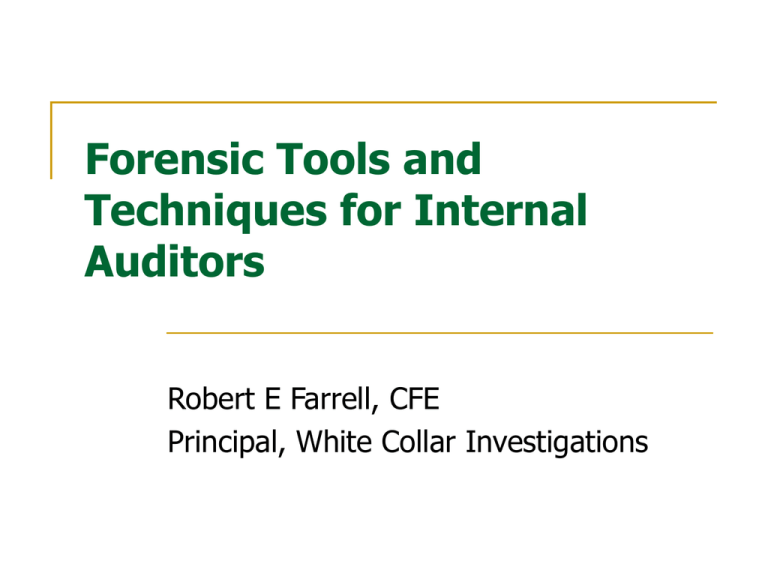
Forensic Tools and Techniques for Internal Auditors Robert E Farrell, CFE Principal, White Collar Investigations Forensic Tools and Techniques for Internal Auditors Internal Audit Responsibilities for Fraud Part of the IA Charter? Perform a Fraud Risk Assessment? Man Hotlines? Proactively search for Fraud? Trained in Fraud prevention, detection, or investigation? Forensic Tools and Techniques for Internal Auditors Public Accountant’s Responsibilities for performing Forensic Services Definition of Forensic Services only defined by AICPA in April 2006 No specific standards for Forensic work Follow the Consulting standards (SCSS -1) Controversy over including forensic in financial statement audits Forensic Tools and Techniques for Internal Auditors Definition of Forensic “used in or suitable to courts of law or public debate” (Black’s Law Dictionary, 8th Edition, 2004) Forensic Tools and Techniques for Internal Auditors Forensic Specialist an individual having expertise and/or training and experience in one or more disciplines that can be used in a forensic environment Forensic Procedures tools and/or techniques employed in the systematic gathering of evidentiary data that can be presented in a court of law Forensic Tools and Techniques for Internal Auditors How is Fraud detected? Tips/Whistleblowers (40%) Internal Audits/Internal Controls (31%) Accident (20%) External Audits (8%) Notified by Police (1%) Forensic Tools and Techniques for Internal Auditors Sources of Tips Employees (57%) Customers (18%) Vendors (13%) Anonymous (12%) Forensic Tools and Techniques for Internal Auditors Red Flags The so-called “Indicia of Fraud” do not necessarily indicate the existence of fraud exercise caution in forming an opinion before investigating Forensic Tools and Techniques for Internal Auditors Some “Indicia” Lack of Corporate Governance no written policies and/or procedures lack of Internal Controls frequent or unusual Related Party transactions Questionable Accounting Activities Management override of Internal Controls unreconciled subsidiary & General Ledger accounts continuous adjustments of book to physical inventories topside Journal Entries Excessive number of manual checks Forensic Tools and Techniques for Internal Auditors Some “Indicia”: (cont’d) Behavioral Issues failure to take vacations living beyond one’s means Insider trading early arrival – late departure Different frauds in different environments each have their own red flags Forensic Tools and Techniques for Internal Auditors Tomorrow it’s there!!! the red flag the tip the accident You now have…… Forensic Tools and Techniques for Internal Auditors Predication “the totality of circumstances that would lead a reasonable, prudent, and professionally trained person to believe that a fraud has occurred, is occurring, or will occur” Forensic Tools and Techniques for Internal Auditors Notification and Plan of Action Who needs to know? (Boss? Audit Committee?, Board of Directors? General Counsel?) What resources do we have to do the work? Do we need help? Where do we get help if we need it? Forensic Tools and Techniques for Internal Auditors Audit procedures Audit software Develop specialized procedures/routines But what else can be done? Forensic Tools and Techniques for Internal Auditors The Seven Recognized Investigative Tools and Techniques Used by Forensic Specialists/Fraud Examiners Forensic Tools and Techniques for Internal Auditors 1. Public Document Reviews and Background Investigations 2. Interviews of Knowledgeable Persons 3. Confidential Sources 4. Laboratory Analysis of Physical and Electronic Evidence Forensic Tools and Techniques for Internal Auditors (cont’d) 5. Physical and Electronic Surveillance 6. Undercover Operations 7. Analysis of Financial Transactions Forensic Tools and Techniques for Internal Auditors Public Document Reviews and Background Investigations Public Databases Secretary of State Websites County Seat Corporate Records Internet UYI Forensic Tools and Techniques for Internal Auditors Public Databases Increasing number of vendors Reliability of data What type of data is available? Forensic Tools and Techniques for Internal Auditors Forensic Tools and Techniques for Internal Auditors Forensic Tools and Techniques for Internal Auditors Forensic Tools and Techniques for Internal Auditors Secretary of State Websites County Seat Can vary by state due to laws Real Estate records; business registrations Corporate Records Stock Transfer records; Accounting data; vendors; competitors; customers Forensic Tools and Techniques for Internal Auditors Internet Search Engines News Sources/Newspapers Telephone Numbers and Addresses Maps Legal Resources Government Sites UYI Forensic Tools and Techniques for Internal Auditors Interviews of Knowledgeable Persons Interview vs. Interrogation Continuous process throughout an investigation Gain additional information with each interview Evidence from witnesses provides additional leads May identify additional witnesses Interview the target only after completing the interviews of the peripheral witnesses Forensic Tools and Techniques for Internal Auditors Confidential Sources Hotlines E-mail Letters Current Employees Former Employees Vendors & former vendors Customers & former customers Forensic Tools and Techniques for Internal Auditors Confidential Sources (cont’d) Cautions Use professional skepticism in assessing information Information supplied to discredit or embarrass the target Weigh the value of the evidence provided against the possibility that it may be false or cannot be proven Validate all evidentiary matter provided Do not assure absolute confidentiality Forensic Tools and Techniques for Internal Auditors Laboratory Analysis of Physical and Electronic Evidence Protection/Validation of Evidence Federal Rules of Evidence Chain of Custody “The only thing worse than a bad document is a bad document that has disappeared!!!” Forensic Tools and Techniques for Internal Auditors Laboratory Analysis of Physical and Electronic Evidence (cont’d) Altered & Fictitious Documents physical examination fingerprint analysis forgeries ink sampling document dating Forensic Tools and Techniques for Internal Auditors Laboratory Analysis of Physical and Electronic Evidence (cont’d) Computer Forensics hard disk imaging E-mail analysis search for erased files analyze use & possible misuse computer software to analyze data Forensic Tools and Techniques for Internal Auditors Physical and Electronic Surveillance Physical usually done by law enforcement or PI’s surveillance cameras can also be used to verify addresses for vendors, employees, etc. Electronic Internet surveillance E-mail Forensic Tools and Techniques for Internal Auditors Undercover Operations usually a recommendation to use can be done best left to professionals Forensic Tools and Techniques for Internal Auditors Analysis of Financial Transactions Horizontal/vertical analysis Authorization of new vendors & employees Comparison of employee & vendor addresses Analysis of sales returns & allowance account Management override of controls Different reviews based on known industry fraud schemes Forensic Tools and Techniques for Internal Auditors Summary Some useful definitions (Forensic, Specialist, Procedures) Fraud detection sources Red Flags Action to be taken The tools & techniques of the forensic specialist
